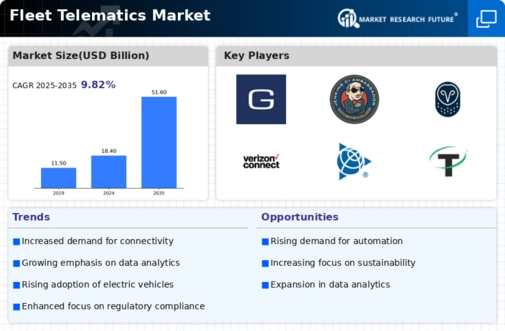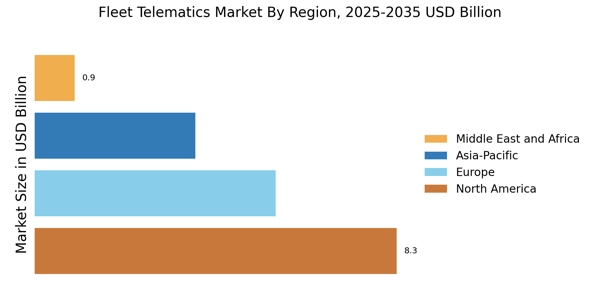The Fleet Telematics Market is currently characterized by a dynamic competitive landscape, driven by technological advancements and an increasing demand for operational efficiency among fleet operators. Key players such as Verizon (US), Geotab (CA), and Samsara (US) are at the forefront, each adopting distinct strategies to enhance their market positioning. Verizon (US) focuses on integrating advanced IoT solutions into its telematics offerings, thereby enhancing data analytics capabilities for fleet management. Meanwhile, Geotab (CA) emphasizes innovation through its open platform, allowing third-party developers to create applications that enhance telematics functionalities. Samsara (US) is leveraging its cloud-based platform to provide real-time insights, which appears to resonate well with customers seeking immediate operational improvements. Collectively, these strategies contribute to a competitive environment that is increasingly centered around technological innovation and customer-centric solutions.
In terms of business tactics, companies are increasingly localizing their operations to better serve regional markets, which may enhance responsiveness to customer needs. The Fleet Telematics Market is moderately fragmented, with a mix of established players and emerging startups. This fragmentation allows for diverse offerings but also intensifies competition among key players, as they strive to differentiate themselves through unique value propositions and enhanced service delivery.
In August 2025, Verizon (US) announced a strategic partnership with a leading AI firm to develop predictive analytics tools for fleet management. This collaboration is poised to enhance Verizon's telematics solutions by providing fleet operators with actionable insights, potentially reducing operational costs and improving safety. The integration of AI into their offerings signifies a shift towards more intelligent fleet management solutions, aligning with broader industry trends towards automation and data-driven decision-making.
In September 2025, Geotab (CA) launched a new suite of sustainability-focused telematics solutions aimed at helping fleets reduce their carbon footprints. This initiative not only addresses growing environmental concerns but also positions Geotab as a leader in the sustainability space within the telematics market. By aligning their product offerings with sustainability goals, Geotab is likely to attract environmentally conscious customers, thereby enhancing its competitive edge.
In October 2025, Samsara (US) expanded its operations into the European market, establishing a new regional office in Germany. This move is indicative of Samsara's commitment to global expansion and its recognition of the growing demand for telematics solutions in Europe. By localizing its presence, Samsara may enhance its ability to cater to European customers, potentially increasing market share in a region that is becoming increasingly competitive.
As of October 2025, the Fleet Telematics Market is witnessing significant trends such as digitalization, sustainability, and the integration of artificial intelligence. Strategic alliances are becoming increasingly pivotal, as companies seek to combine strengths and enhance their technological capabilities. The competitive landscape is likely to evolve, with a pronounced shift from price-based competition towards differentiation through innovation, advanced technology, and reliable supply chains. This evolution suggests that companies that prioritize these aspects will be better positioned to thrive in the future.


















Leave a Comment